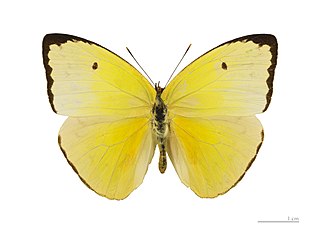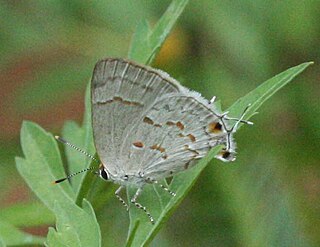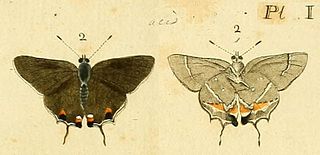
Lantana is a genus of about 150 species of perennial flowering plants in the verbena family, Verbenaceae. They are native to tropical regions of the Americas and Africa but exist as an introduced species in numerous areas, especially in the Australian-Pacific region, South and Northeastern part of India and Bangladesh. The genus includes both herbaceous plants and shrubs growing to 0.5–2 m (1.6–6.6 ft) tall. Their common names are shrub verbenas or lantanas. The generic name originated in Late Latin, where it refers to the unrelated Viburnum lantana.

The great purple hairstreak, also called the great blue hairstreak, is a common gossamer-winged butterfly species in parts of the United States. It is actually a Neotropical species; its North American range only includes the warm-temperate and subtropical parts of that continent, and it ranges southwards almost to the Isthmus of Panama. The type specimen, however, was shipped to Europe from the Colony of Virginia, probably around the time of the United States Declaration of Independence.

Dryas iulia, commonly called the Julia butterfly, Julia heliconian, the flame, or flambeau, is a species of brush-footed butterfly. The sole representative of its genus Dryas, it is native from Brazil to southern Texas and Florida, and in summer can sometimes be found as far north as eastern Nebraska. Over 15 subspecies have been described.

The gray hairstreak is also called the bean lycaenid or cotton square borer. It is a member of the Lycaenidae family, known as the gossamer-winged butterflies and the second-largest family of butterflies. It is one of the most common hairstreaks in North America, ranging over nearly the entire continent. It also occurs throughout Central America and in northern South America.

The western pygmy blue is one of the smallest butterflies in the world and the smallest in North America. It has reached Hawaii, as well as the Persian Gulf, including eastern Saudi Arabia, Bahrain and the United Arab Emirates.

The Sandia hairstreak is a species of butterfly native to North America. A relatively rare butterfly with a limited range, it was discovered in La Cueva Canyon, Albuquerque, in spring of 1958, by Noel McFarland, then a student at the University of Kansas, and described the following year. The Sandia hairstreak was made one of the state insects of New Mexico in a 2002 bill approved the following year.

Strymon is a genus of scrub hairstreak butterflies in the family Lycaenidae. It is a highly distinct lineage in the tribe Eumaeini, and was at one time even treated as a monotypic tribe Strymonini. The species of the genus are found in the Nearctic, the Palearctic and the Neotropical realms.

Callophrys gryneus, the juniper hairstreak or olive hairstreak, is a butterfly native to North America. It belongs in the family Lycaenidae.

The silky hairstreak or chlorinda hairstreak is a butterfly belonging to the family Lycaenidae. The species was first described by Emile Blanchard in 1848. It occurs in Australia. It is the only species in the monotypic genus Pseudalmenus, described by Hamilton Herbert Druce in 1902.

Aphrissa statira, the statira sulphur, is a species of Lepidoptera in the family Pieridae. The species is a medium-sized yellow butterfly, with females more pale than males. They are found from southern regions of Florida and Texas through southern Brazil and northern Argentina. The caterpillars feed on the leaves of several local host plants, while adults prefer to feed on the nectar of red or orange colored flowers. The species is most noted for their dramatic migrations in the tropical areas of the Americas. They have been the subject of many studies about how butterflies navigate and orient during migration.

Chlorostrymon simaethis, the silver-banded hairstreak, is a North and South American butterfly in the family Lycaenidae. It is also known as St. Christopher's hairstreak and the Key lime hairstreak.

Callophrys sheridanii, the Sheridan's hairstreak and Sheridan's green hairstreak, is a butterfly in the family Lycaenidae. It is found in North America along the south coast of British Columbia and parts of Nevada, Arizona, Saskatchewan, North Dakota, and New Mexico. In 2009, this species was adopted as the U.S. state butterfly for Wyoming.

Tmolus echion, the red-spotted hairstreak or larger lantana butterfly, is a butterfly in the family Lycaenidae. It is found from Brazil, north to Sinaloa and Tamaulipas in Mexico. Rare strays can be found in southern Texas. It was introduced to Hawaii in 1902 to control lantana.

Satyrium liparops, the striped hairstreak, is a butterfly of the family Lycaenidae described by John Eatton Le Conte in 1833. It is found in North America, from the Rocky Mountains south from southern Canada to Colorado, east to Maine and south to Florida.

Strymon albata, the white hairstreak, is a butterfly of the family Lycaenidae. It was described by Cajetan Felder and Rudolf Felder in 1865. It is found from southern Texas to Costa Rica, Colombia, Venezuela and Trinidad.

Strymon alea, the Alea hairstreak or Lacey's scrub-hairstreak, is a butterfly of the family Lycaenidae. It was described by Frederick DuCane Godman and Osbert Salvin in 1887. It is found from north-western Costa Rica through Mexico to central and southern Texas. The habitat consists of subtropical thorn scrub.

Strymon istapa the mallow hairstreak, mallow-scrub hairstreak, dotted hairstreak or Hewitson's hairstreak. This diurnal butterfly is a widespread species that can be found in xeric habitats throughout the southern United States, Central America, parts of the Caribbean, and rarely in South America. This species can be spotted in rural and suburban areas in which human infringement has created open fields or tracks of overgrown weeds as a result of land clearing. These butterflies are often seen rubbing their hindwings together presumably to attract attention to their antenna mimicry scales located on the outer margin of the hindwing.

Strymon acis, the Bartram's scrub-hairstreak, is a butterfly of the family Lycaenidae. It is found in southern Florida and the West Indies. The habitat consists of openings in pine woods.

Callophrys xami, commonly referred to as the xami hairstreak or green hairstreak, is a butterfly included in the subgenus Xamia and the genus Callophrys in the family Lycaenidae. It was described by Tryon Reakirt in 1867. Other common names for this species, depending on the region, include green hairstreak and elfin. C. xami is considered to be a very rare species of butterfly, and its typical range is in southern Arizona and Texas including down south to Guatemala. The juniper hairstreak and the silver-banded hairstreak butterflies are similar species, but both differ significantly from C. xami in regards to the postmedian white line running across the butterfly wings.



















